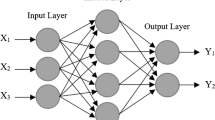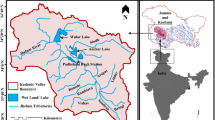Abstract
The pipes as one of the main and important components of a water distribution network break during operation due to various factors. Developing models for pipes failure rate prediction can be one of the most important tools for managers and stakeholders during optimal operation of the water distribution network. In this study, the statistical and soft models such as Linear Regression, Generalized Linear Regression, Support Vector Machine, Feed Forward Neural Network (FFNN), Radial-Based Function Neural Network (RBFNN), and Adaptive Neuro-Fuzzy Inference System (ANFIS) were studied in order to predict the pipes failure rate based on the characteristics of Gorgan city water distribution network including diameter, length, age, installation depth, and number of failures of each pipe. In order to determine the optimal values of the parameters of each model, appropriate error indices including correlation coefficient (R), Mean Square Error (MSE), and Correlation Mean Square Error Ratio (CMSER) for training and test data were calculated, and the values of the parameters related to the model with the highest value of the CMSER index were considered as the model optimal values. Furthermore, in the validation stage, the values of R and MSE error indices for each of the above models were considered as a criterion for selecting the most appropriate model for predicting pipe failure rate. The findings show that among the soft and statistical models investigated, ANFIS with MSE of 0.071 and R of 0.92 can predict the failure rate of the studied network pipes more efficiently and more accurately than other models. Yet, despite the superiority of this model over other models, this model cannot accurately predict the failure rate of the studied network pipes due to its relatively high MSE value. Therefore, a new approach was developed based on the hybridization of trained models to provide a more efficient model for a more accurate prediction of the pipe failure rates of water distribution network. In this approach, the values of the network pipe failure rate predicted by each of the soft and statistical models are considered as independent input variables, and the observational failure rate values are considered as the dependent output variable of the ANFIS model. A comparison between the values of non-hybrid model validation data indices and the results of the proposed hybrid prediction model reveals that the use of the developed hybrid model increased the R error value from 8.1% (compared to the ANFIS model) to 260% (compared to the RBFNN model). It also decreased the MSE error value from 37% (compared to the FFNN model) to 58% (compared to the RBFNN model). Moreover, the hybrid model, compared to the superior non-hybrid ANFIS model, decreased MSE error rates by 45%. The findings show that the proposed model can significantly raise the accuracy of predicting the failure rate of pipes, compared to other existing models.


















Similar content being viewed by others

References
Asnaashari A, McBean EA, Gharabaghi B, Tutt D (2013) Forecasting watermain failure using artificial neural network modelling. Can Water Resour J 38(1):24–33
Aydogdu M, Firat M (2015) Estimation of failure rate in water distribution network using fuzzy clustering and LS-SVM methods. Water Resour Manag 29(5):1575–1590
Barton NA, Farewell TS, Hallett SH, Acland TF (2019) Improving pipe failure predictions: factors effecting pipe failure in drinking water networks. Water Res 164:114926. https://doi.org/10.1016/j.watres.2019.114926
Berardi L, Giustolisi O, Kapelan Z, Savic DA (2008) Development of pipe deterioration models for water distribution systems using EPR. J Hydroinf 10(2):113–126
Fares H, Zayed T (2010) Hierarchical fuzzy expert system for risk of failure of water mains. J Pipeline Syst Eng Pract 1(1):53–62
Faris Hamdala K, Sagar GY (2016) Statistical analysis of pipe breaks in water distribution systems in Ethiopia, the case of Hawassa. IOSR J Math 12(3):127–136
Farmani R, Kakoudakis K, Behzadian Moghadam K, Butler D (2017) Pipe failure prediction in water distribution systems considering static and dynamic factors. Proc Eng 186:117–126
Frey HC, Patil SR (2002) Identification and review of sensitivity analysis methods. Risk Anal 22:553–578
Gasemnezhad S, Motiee H, Moosavi Nodoushan MS (2014) Prediction of damage rate of urban drinking water network pipes by using and developing statistical models. In: Iranian water and sewerage science and engineering congress (in Persian)
Golbraikh A, Tropsha A (2002) Beware of q2! J Mol Graph Model 20(4):269–276
Harvey R, McBean EA, Gharabaghi B (2013) Predicting the timing of water main failure using artificial neural networks. J Water Resour Plan Manag 140(4):425–434
Ho CI, Lin MD, Lo SL (2010) Use of a GIS-based hybrid artificial neural network to prioritize the order of pipe replacement in a water distribution network. Environ Monit Assess 166(1–4):177–189
Islam MS, Sadiq R, Rodriguez MJ, Francisque A, Najjaran H, Hoorfar M (2011) Leakage detection and location in water distribution systems using a fuzzy-based methodology. Urban water J 8(6):351–365
Jafar R, Shahrour I, Juran I (2010) Application of Artificial Neural Networks (ANN) to model the failure of urban water mains. Math Comput Model 51(9–10):1170–1180
Kakoudakis K, Behzadian K, Farmani R, Butler D (2017) Pipeline failure prediction in water distribution networks using evolutionary polynomial regression combined with K-means clustering. Urban Water J 14(7):737–742
Kapelan ZS, Savic DA, Walters GA (2003) A hybrid inverse transient model for leakage detection and roughness calibration in pipe networks. J Hydraul Res 41(5):481–492
Kerwin S, de Soto BG, Adey BT (2019) January. Performance comparison for pipe failure prediction using artificial neural networks. In 6th international symposium on life-cycle civil engineering, IALCCE 2018. CRC Press/Balkema, pp 1337–1342
Kleiner Y, Rajani B (2002) Forecasting variations and trends in water-main breaks. J Infrastruct Syst 8(4):122–131
Malekpour MM, Tabari MMR (2020) Implementation of supervised intelligence committee machine method for monthly water level prediction. Arab J Geosci 13(19):1–14. https://doi.org/10.1007/876s12517-020-06034-x
Mounce SR, Day AJ, Wood AS, Khan A, Widdop PD, Machell J (2002) A neural network approach to burst detection. Water Sci Technol 45(4–5):237–246
Pandey P, Dongre S, Gupta R (2020) Probabilistic and fuzzy approaches for uncertainty consideration in water distribution networks: a review. Water Supply 20(1):13–27
Rajani B, Kleiner Y (2001) Comprehensive review of structural deterioration of water mains: physically based models. Urban Water 3(3):151–164
Rajeev P, Kodikara J, Robert D, Zeman P, Rajani B (2014) Factors contributing to large diameter water pipe failure. Water Asset Manag Int 10(3):9–14
Robles-Velasco A, Cortés P, Muñuzuri J, Onieva L (2020) Prediction of pipe failures in water supply networks using logistic regression and support vector classification. Reliab Eng Syst Saf 196:106754. https://doi.org/10.1016/j.ress.2019.106754
Rogers PD (2011) Prioritizing water main renewals: case study of the Denver water system. J Pipeline Syst Eng Pract 2(3):73–81
Sacluti FR (1999) Modelling water distribution pipe failures using artificial neural networks. MSc. thesis, Department of Civil and Envir. Eng. University of Alberta, Canada
Sadiq R, Kleiner Y, Rajani B (2007) Water quality failures in distribution networks risk analysis using fuzzy logic and evidential reasoning. Risk Anal Int J 27(5):1381–1394
Sattar AM, Gharabaghi B (2015) Gene expression models for prediction of longitudinal dispersion coefficient in streams. J Hydrol 524:587–596
Sattar AM, Gharabaghi B, McBean EA (2016) Prediction of timing of watermain failure using gene expression models. Water Resour Manag 30(5):1635–1651
Sattar AM, Ertuğrul ÖF, Gharabaghi B, McBean EA, Cao J (2019) Extreme learning machine model for water network management. Neural Comput Appl 31(1):157–169
Shamir U, Howard CD (1979) An analytic approach to scheduling pipe replacement. J Am Water Works Assoc 71(5):248–258
Shin H, Kobayashi K, Koo J, Do M (2015) Estimating burst probability of water pipelines with a competing hazard model. J Hydroinf 18(1):126–135
Soltani J, Tabari MMR (2012) Determination of effective parameters in pipe failure rate in water distribution system using the combination of artificial neural networks and genetic algorithm. J Water Wastewater 23(83):2–15 (In Persian)
Soltanjalili M, Bozorg-Haddad O, Mariño MA (2011) Effect of breakage level one in design of water distribution networks. Water Resour Manag 25(1):311–337
Tabari MMR, Malekpour Shahraki MM (2018) Reservoir water level prediction using supervised intelligent committee machine method, case study: Karaj Amirkabir Dam. Iran Water Resour Res 14(5):15–30 (in Persian)
Tabari MMR, Zarif Sanayei HR (2019) Prediction of the intermediate block displacement of the dam crest using artificial neural network and support vector regression models. Soft Comput 23(19):9629–9645
Tabari MMR, Azari T, Dehghan V (2020) A supervised committee neural network for the determination of aquifer parameters: a case study of Katasbes aquifer in Shiraz plain, Iran. Soft Comput. https://doi.org/10.1007/s00500-020-05487-2
Tabesh M, Soltani J, Farmani R, Savic D (2009) Assessing pipe failure rate and mechanical reliability of water distribution networks using data-driven modeling. J Hydroinf 11(1):1–17
Tavakoli R, Najafi M, Sharifara A (2019) Artificial neural networks and adaptive neuro-fuzzy models for prediction of remaining useful life. arXiv:1909.02115
Tropsha A, Gramatica P, Gombar VK (2003) The importance of being earnest: validation is the absolute essential for successful application and interpretation of QSPR models. QSAR Comb Sci 22(1):69–77
Tu MY, Tsai FTC, Yeh WWG (2005) Optimization of water distribution and water quality by hybrid genetic algorithm. J Water Resour Plan Manag 131(6):431–440
Valis KPU (2013) Application of fuzzy logic for failure risk assessment in water supply system management. CEST
Verbeeck H, Samson R, Verdonck F, Raoul L (2006) Parameter sensitivity and uncertainty of the forest carbon flux model FOUG: a Monte Carlo analysis. Tree Physiol 26:807–817
Walker H (1931) Studies in the History of the Statistical Method. Williams and Wilkins Co., Baltimore, pp 24–25
Wang Y, Zayed T, Moselhi O (2009) Prediction models for annual break rates of water mains. J Perform Constr Facil 23(1):47–54
Xu Q, Chen Q, Li W, Ma J (2011) Pipe break prediction based on evolutionary data-driven methods with brief recorded data. Reliab Eng Syst Saf 96(8):942–948
Xu Q, Chen Q, Ma J, Blanckaert K (2013) Optimal pipe replacement strategy based on break rate prediction through genetic programming for water distribution network. J Hydro Environ Res 7(2):134–140
Yoon H, Jun SC, Hyun Y, Bae GO, Lee KK (2011) A comparative study of artificial neural networks and support vector machines for predicting groundwater levels in a coastal aquifer. J Hydrol 396:128–138
Zangenehmadar Z, Moselhi O (2016) Application of neural networks in predicting the remaining useful life of water pipelines. In: Pipelines 2016, pp 292–308
Author information
Authors and Affiliations
Corresponding author
Ethics declarations
Conflict of interest
The authors declare that they have no conflict of interest.
Ethical approval
This article does not contain any studies with human participants or animals performed by any of the authors.
Additional information
Publisher's Note
Springer Nature remains neutral with regard to jurisdictional claims in published maps and institutional affiliations.
Rights and permissions
About this article
Cite this article
Jafari, S.M., Zahiri, A.R., Bozorg Hadad, O. et al. A hybrid of six soft models based on ANFIS for pipe failure rate forecasting and uncertainty analysis: a case study of Gorgan city water distribution network. Soft Comput 25, 7459–7478 (2021). https://doi.org/10.1007/s00500-021-05706-4
Accepted:
Published:
Issue Date:
DOI: https://doi.org/10.1007/s00500-021-05706-4



